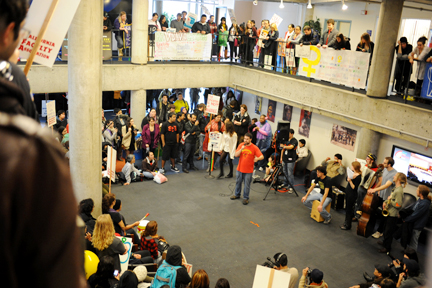Schools unite for Day of Action

By Matthew Gomez and Estela Fuentes
The Guardsman
City College and SF State students gathered March 2 in solidarity to protest looming budget cuts to higher learning institutions that will reduce classes and other benefits for students throughout California.
The demonstrations started at SF State, where some 500 students and faculty gathered in the Cesar Chavez Student Center to listen to speeches, spoken word and songs about budget cuts.
The rallies had fewer attendees than last year, when an estimated 10,000 people gathered at Civic Center Plaza to protest cuts in education.
“The outreach was less this year,” said Felix Cabrera, City College vice president of cultural affairs and City College Save Our Schools member who helped organize the events. “The reason is there was a lack of communication and collaboration between all the different organizations.”
But Cabrera said he was not dismayed because the goal of the rally was to spread the word and inform people, which he said it achieved.
According to City College’s annual financial report, the 2011-12 projected budget deficit will amount to somewhere between $17.5 million and $35 million.
“Faculty is supporting the students because the mission of the campus is to educate students,” said Sheila Tully, lecturer vice president of the executive board of the California Faculty Association. “We, as teachers, understand what cuts are doing to the education system.”
Marisa Soski, a junior at S.F. State and volunteer with Students for Quality Education, said the budget problems pose a threat not only to students, but also to faculty and staff.
“It is really important that students write to their representatives,” Soski said. “It is our responsibility to be aware.”
Other students agreed that students needed to do more to save education.
“We can only go so far with days of action,” said Jesse Sabin, 25, an environmental studies major at S.F. State. “It’s kind of an empty gesture.”
Later that night, more than 200 people gathered at City College’s Mission campus for a town hall forum as part of the Unified Day of Action.
Various speakers discussed how the budget cuts affected them and ways the state budget could be reworked to provide more education funding. High school students said increased college tuition prices were discouraging them from attending and college instructors spoke about the importance of education.
Fred Glass, director of the California Federation of Teachers, discussed the benefits a progressive tax would have on the state budget.
Glass also spoke at a small teach-in at the Student Union building on March 1. He said California’s budget problems could be eased if taxes were raised on the rich and that tax brackets should be raised to 11 percent for the wealthy. At 9.3 percent, California has one of the lowest tax rates for people earning $250,000 to $500,000.
Some prominent community members also offered their perspectives on the budget cuts.
“People need to vote no against cuts when given a choice,” Kim Shree-Maufas, commissioner of San Francisco’s Board of Education, said. She was the lone no vote in a recent 6-1 decision to lay off some 500 San Francisco teachers, administrators and aides.
City College students are also invited March 14 to the “March on Sacramento,” where community college students from around California will gather to protest on the steps of the state capitol building.
Peter Hernandez and Brant Ozanich contributed to this report.
